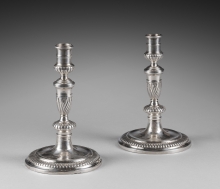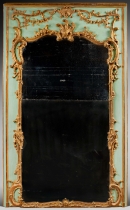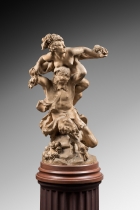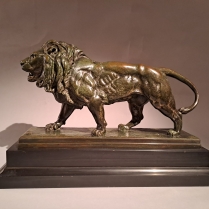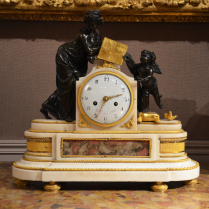Antoine Louis Barye (1795-1875) - Walking lion, large model
Dimensions : H. 23 x W. 41 x D.10 cm
A very fine late 19th century proof in bronze with brown and green patina.
Black marble pedestal, dimensions with pedestal: L. 46 x H. 31 x D. 16 cm
Signed on the terrace:
- Signed on the terrace: "BARYE
- F.BARBEDIENNE.FONDEUR" engraved
- GOLD stamp "FB
Numbered under the terrace:
- n°38 engraved
- n°5735 in ink
Antoine Louis Barye was born in Paris in 1795.
He is without doubt the greatest animal sculptor of the 19th century. In 1818, Barye entered the Paris School of Fine Arts in the studio of the sculptor Bosio and the painter Gros. Teaching at the beginning of the century was purely academic, but from the start of his apprenticeship, Barye sought to demonstrate his romantic and modernist vision of sculpture. Despite the resistance of classicism, the talent of this visionary artist was recognised, and Barye was awarded the second Prix de Rome in 1820. He left the school in 1825, preferring to study living animals tirelessly at the Jardin des Plantes in Paris. Théophile Gautier dubbed him the "Michelangelo" of the menagerie, where he studied animals ad-vivum with his friend Eugène Delacroix. Both artists had a predilection for fawns, whose power and suppleness captivated them. Barye demonstrated an almost scientific rigour, attending dissections of dead animals to immerse himself in the animals' bodies, their fur and above all their musculature.
But Antoine Barye's genius lay in his ability to go beyond this realism, which he mastered perfectly, by giving animals a new, stylised aesthetic. He was followed by two other great innovators in animal sculpture, Rembrandt Bugatti and François Pompon. This new aesthetic was widely adopted in the decorative arts of the early 20th century.
During his lifetime, Barye received prestigious commissions from the Duc d'Orléans, Louis Philippe and the Musée du Louvre. After his death in 1875, most of his plaster casts and models were bought by Ferdinand Barbedienne, the famous metallurgist and best foundryman of the time. Until 1900, Barbedienne cast bronzes from Barye's original models. The casts were made with extreme attention to detail. Today, most of Barye's plaster casts and original models are the property of the Louvre.
Barye's bronzes are preserved in countless museums around the world.






